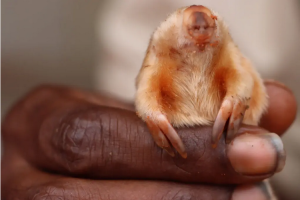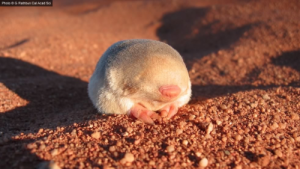Podcast: Play in new window | Download (Duration: 12:12 — 12.4MB)
Subscribe: | More
This week we’ll learn all about venomous mammals: what are they, will they kill you, and why aren’t humans venomous because that would be cool. While you’re pondering your lack of venom, hop on over and enter my Goodreads giveaway for my new book Skytown! (Canada and U.S. only, sorry.)
The adorable and venomous water shrew:
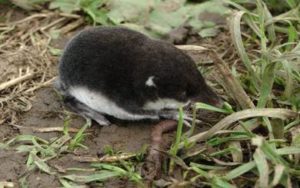
The adorable and venomous European mole!
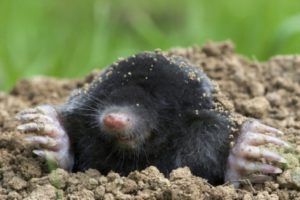
The adorable and venomous Hispaniolan solenodon (there is a pattern in this episode)!
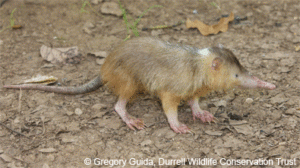
The adorable and venomous Cuban solenodon!
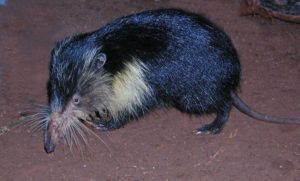
Show transcript:
Welcome to Strange Animals Podcast. I’m your host, Kate Shaw.
For this week’s episode, we’re going to learn about venomous mammals. But first, an ad! Okay, not a real ad. If I ever do run advertisements on the podcast, I’ll put them at the very end so you don’t have to listen if you don’t want to. But I do want to tell you about my new book! It’s called Skytown and it’s published by Fox Spirit Books, a small British publisher you should totally support. All their books are good. Skytown is a fantasy adventure about two ladies who are airship pirates. The book isn’t intended for kids, but I estimate it at about a PG-13 rating—it has some bad language and some mild adult behavior and violence, but nothing adults only.
Right now I’ve got a Goodreads giveaway going on through the end of September 2017 for a paperback copy of Skytown, although in this case entries are limited to people in the United States or Canada. I’ll put a link to the giveaway page in the show notes in case you’re interested in entering, or if you just want to learn more about the book. It doesn’t have a whole lot to do with strange animals, although there are a few that are important to the plot, but I think it’s a lot of fun.
But now, back to the venomous mammals, and I get to work in a sneaky shout-out to the awesome podcast Varmints! In a recent episode about frogs, one of the hosts gives a good way to remember the difference between venomous and poisonous. If an animal bites you and you die, it’s venomous. If you bite an animal and then you die, the animal is poisonous. There are lots of venomous insects, lots of venomous reptiles, lots of venomous fish, lots of venomous amphibians, but not very many venomous mammals. Oh, and no venomous birds, but more about that later.
We’re most used to venomous snakes that inject poison with their fangs, but there are lots of ways to get venom into potential prey or a potential predator. Scorpions and bees inject venom with a stinger, for instance. Stingrays have barbed stingers on their tails, while some fish such as scorpionfish and dogfish sharks have sharp spines that are coated with toxins. Other fish, like stonefish, have spines that actually inject venom. Some lizards, including gila monsters and komodo dragons, have modified salivary glands in the lower jaw that contain venom, which is leached into a bite through the lower teeth, not through specialized fangs. Some types of amphibians, like the sharp-ribbed newt, actually puncture their own sides with their ribs when threatened, secreting toxins at the same time that coat the points of the ribs. And while poison dart frogs don’t inject venom, just secrete it and dare other animals to lick them, a few species of frog have little spines on the skull that injects venom when the frog headbutts an animal.
Most venom is a toxin that either renders prey helpless or kills it outright, or produces pain or adverse physical symptoms in predators. So it’s controversial to suggest that the anticoagulant found in vampire bat saliva is actually a venom. Likewise, the slow loris secretes a strong-smelling substance when threatened that can cause allergic reactions in some individuals but which isn’t technically a toxin.
Several species of shrew are definitely venomous, including the Eurasian water shrew. Water shrews are neat little animals even without venom. They’re around 4 inches long with a tail some 3 inches long. Like other shrews, its teeth have red tips due to iron concentrated in the enamel, which helps strengthen the tooth and keep it from wearing down as fast. The water shrew can only stay underwater about 20 seconds before needing to surface, but its fur traps air so water can’t get down to its skin. It also makes it look silvery if you get a picture of it as it’s diving. It lives in burrows near water and mostly eats aquatic organisms like fish, insects, snails, and amphibians. It mostly uses its sensitive whiskers to find prey.
And yes, it’s venomous. While its jaws aren’t strong enough to injure humans and other large mammals, it does a great job against small animals. The venom is present in its saliva, so when a shrew bites its prey, saliva naturally gets into the wound.
The European mole has venomous saliva too. Mostly it uses its venom to paralyze earthworms, which it eats, but it also sometimes eats shrews. Irony! Moles are around 4 to 6 inches long with strong forelegs with long claws that it uses to dig its burrows. Moles do have eyes and can see, but their eyes are tiny and protected by fur that grows over them. Its ears are similarly tiny and protected. The mole constructs elaborate tunnel systems and spends most of its life underground. It’s a solitary animal but like the old lady who lives up the hill from me, it always seems to know what its neighbors are up to. If a mole dies or is captured and removed from its burrow, its neighbors promptly move in on its territory. Earthworms are its favorite food but it will also eat insects.
The male platypus has a spur on the ankles of its hind feet that can inject venom. While venom is present through the year, its production is increased during the breeding season. Some researchers believe the venom is used when males fight each other. But the venom is incredibly toxic. It can kill animals as big as dogs outright, and while it won’t kill a human, it can certainly make the human wish they were dead. Not only is the pain excruciating and lasts for weeks, it can cause a heightened sensitivity to all pain for months. That seems a little like overkill. One good thing, though, is that recent research has isolated a form of insulin in the platypus’s venom that normally degrades very quickly, but that is much longer-lasting in the venom. Scientists are hopeful that learning more about it can lead to new treatment of diabetes in humans.
I swear I’m still planning an episode about platypuses pretty soon. They and their close cousins, echidnas, are freaky-deaky animals. So let’s skate right by the platypus for now and go on to discuss another freaky-deaky animal that you may not have heard of, the solenodon.
There are two species of solenodon, the Cuban and the Hispaniolan. They look a bit like small possums or big shrews, with long noses and long tails without fur. They climb well, although they can’t jump, and have relatively long legs, and they basically walk on their tiptoes. They can also be surprisingly clumsy, sometimes tripping themselves and tumbling to the ground. I thought I was the only one who did that. The Hispanolian solenodon is pale reddish-brown and gray while the Cuban solenodon is brown with a yellow-white face or head. Both are about a foot long not counting their eight-inch tails, and both have glands that secrete a musky smell.
The solenodon is one of those animals people like to call a living fossil. It’s been around since well before the dinosaurs went extinct, some 76 million years ago, and retains a number of characteristics considered primitive. There used to be a species in North America, but it went extinct sometime in the last two million years.
Females give birth to one or two babies at a time. Occasionally a litter of three is born, but the mother only has two teats, located toward the back of her belly and elongated so the babies can travel with her while they continue to nurse. That means a third baby doesn’t get much to eat.
The solenodon mostly eats insects and earthworms, but they’ll snack on just about anything, including carrion, fruit, and small animals. Two of the lower incisors have grooves, and when a solenodon bites, it injects venom into its prey through the grooves from modified salivary glands. The venom isn’t strong enough to kill a human, but it is painful. One solenodon kept in captivity in London bit a chicken, then ate it. Even though the chicken was bigger than he was.
The solenodon is shy and nocturnal. Its eyesight isn’t very good, but that’s okay, because it uses a form of echolocation to navigate and find prey. As it walks, it generates quiet clicking sounds the same way bats squeak, and it can interpret the echoes of its sounds to know what’s around it. It has good hearing and a very good sense of smell. Its long nose is extremely flexible—in fact, the Hispaniolan solenodon has a joint at the base of its snout to make it even more flexible. Since a lot of its prey hides in tree bark or crevices in the ground, it needs an extra investigative snoot.
You wouldn’t think such a little animal that mostly eats insects would be a big deal in the animal world, but until Europeans showed up on the island of Hispanolia, the Hispaniolan solenodon was pretty much a bigwig. Nothing ate it except the occasional eagle, so when Europeans showed up with dogs, cats, rats, and mongooses, the solenodon had no idea how to defend itself. While dogs bitten by solenodons do sometimes die, cats and rats eat a lot of the same prey the solenodon does and can outcompete it. The mongoose just eats the solenodon. The Cuban solenodon was similarly threatened by deforestation and introduced species. By 1970 researchers believed the solenodon was extinct. Fortunately, they were wrong, although both species are still rare. There used to be a population of the Hispaniolan solenodon in Haiti, but those do appear to be gone since there are few forested areas left for them to live in.
So why do a few mammals have venom while most of us don’t? Some researchers think venom used to be really common in mammals when dinosaurs were still alive. It was a useful defense when almost everything was bigger than mammals. But after most dinosaurs went extinct, and mammals began to evolve to fit new ecological niches, venom wasn’t as useful. Most mammal lineages lost the venom. Then again, we don’t know for sure if this is the case. Some other researchers think venom was never that common in mammals to start with. It’s hard to tell if an animal was venomous from fossil remains.
I mentioned earlier that no known venomous birds exist, but there are a few birds that make use of toxins from plants or insects they eat. For instance, the African spur-winged goose eats a lot of blister beetles, and blister beetles are toxic. If you touch one, it will secrete the toxin that’s powerful enough to raise blisters on your skin. Blister beetles are attracted to blooming alfalfa plants, which can cause a lot of problems for horses if any of the beetles are collected when the plants are dried and baled for hay. A couple of dead blister beetles in a single feeding of hay can kill the horse that eats them. But the spur-winged goose is immune to the beetle’s toxin. It collects the toxin in its tissues, which makes it poisonous. People have actually died as a result of eating its meat. Oh, and the goose has spurs on its wings—thus its name—that it uses to defend its territory from other birds. But the spurs aren’t venomous, although that would be really metal.
You can find Strange Animals Podcast online at strangeanimalspodcast.com. We’re on Twitter at strangebeasties and have a facebook page at facebook.com/strangeanimalspodcast. If you have questions, comments, or suggestions for future episodes, email us at strangeanimalspodcast@gmail.com. If you like the podcast and want to help us out, leave us a rating and review on iTunes or whatever platform you listen on. We also have a Patreon if you’d like to support us that way. Rewards include stickers and twice-monthly bonus episodes.
Thanks for listening!
